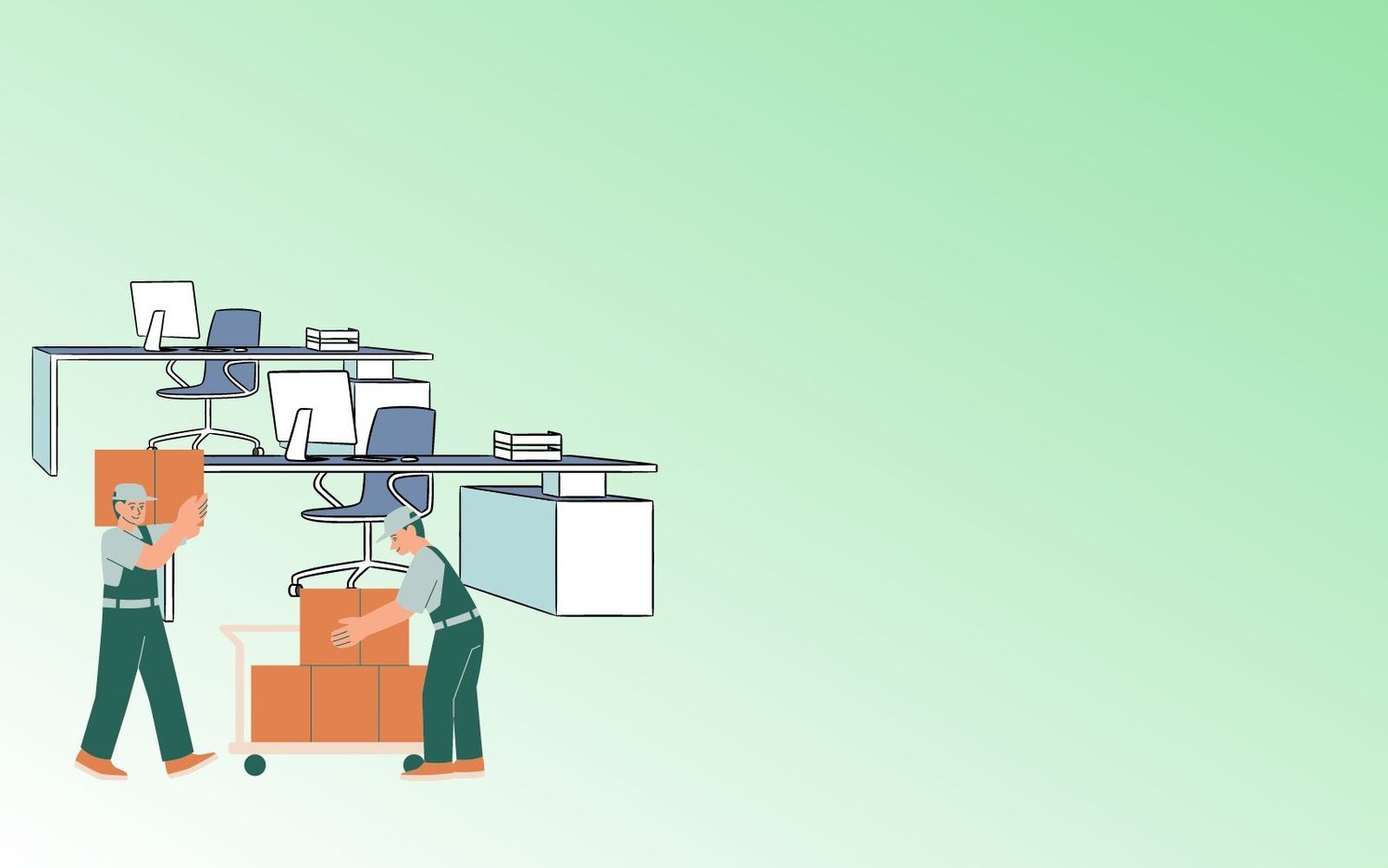New Office IT Setup: Guide To A Seamless Office Move
We are digital creatures who need and love to stay connected. So it's no surprise that when moving to a new house, we first set up the WiFi. Even on vacation, the first thing we do when checking in to our hotel is to connect to the WiFi.
Businesses are no different. Modern organizations are extremely dependent on technology, especially the Internet. Without computers, internet connectivity, and cloud applications, it is extremely difficult, if not impossible, to get things done.
Therefore, whatever the reason for moving, whether it be the need for expansion, financial considerations, a more desirable location, or upgrading working conditions, when an organization moves into a new office space, the IT setup takes priority over everything else.
This blog post is a quick guide to help you plan and execute the IT setup in your new space to ensure that the office move is smooth and seamless.
Before The Move
Here are the things you need to do to plan and prepare for your move:
1. Assess Current IT Setup
The first thing you need to do before even planning your move is to gauge the quantum and complexity of work that will be required. So, you’ll need to take stock of all IT equipment, including hardware, software, peripherals, servers, and networking devices, currently being used. You’ll also need to document the existing network infrastructure, configurations, and connections to facilitate the setup in the new office.
Office relocations present an excellent opportunity to refresh or replace your aging IT equipment. This can help shed some of the technical debt your organization may have accumulated through expedient choices of technology in the past. So consider retiring that outdated networking equipment, bulky monitors, and sluggish video conferencing gear, leaving the inefficiencies of obsolete technology behind.
2. Decide Whether You Will Do-It-Yourself Move Or Use An IT Services Provider
Relocating an organization’s entire IT infrastructure is not a single-handed job. The assessment of your current IT setup should give you an idea of the work involved in the move and IT setup at the new location.
Although the physical aspects of the relocation may not be complex, the complete relocation is much more complex and includes:
setup and configuration of wired and wireless networks,
proper shutdown, transportation, and reinstallation of servers,
physical security systems, such as access control systems, surveillance cameras, and alarm systems, and
secure packing, transportation, and set up in the new office to minimize downtime for employees.
Even if you think you have everything under control, it is better to delegate the work to IT relocation and office move professionals like Jones IT. IT relocation specialists will not only mitigate the risk to your IT equipment during transit but will also be able to troubleshoot and resolve any issues that may pop up when installing and configuring the devices in the new location. The whole process will go a lot faster and you will be pleasantly surprised how seamless the relocation process will be.
3. Review Office Floor Plan From An IT Perspective
The next step is to assess the new space from an IT perspective. You will need a detailed floor plan, including power outlets, network ports, cabling infrastructure, and heating, ventilation, and air conditioning (HVAC). This information is important as it helps decide where you will house servers, locate networking equipment, create conference rooms, and place printers, copiers, and scanners.
Optimizing the location and layout of your IT infrastructure helps minimize cabling and ensures reliable and high-speed WiFi connectivity in the new location. Additionally, it helps ensure proper ventilation, ease of access for maintenance, and physical security of the IT infrastructure.
Here are a few key things to fix on the office floor plan:
Location of server room, network rack, printers, copiers, and scanners,
The number and locations of dedicated conference rooms,
Distribution of workstations and laptops to determine network and WiFi loads.
4. Design The Network Infrastructure
Relocating to a new office space very often requires a redesign of the network to better accommodate the new office layout, size, and connectivity needs. This may require you to augment the existing network with new switches and access points (APs), or in many cases, a complete redesign of the network.
Typically, a relocation is a great time to upgrade an aging network infrastructure since the relocation already involves a lot of work that is necessary for network upgrades, such as laying Ethernet cables, cable management, and installation of APs as well as configurations and testing.
If your relocation project requires a network redesign, we’ve got you covered. Here are links to resources that will help you design a secure and efficient network:
Designing A Computer Network For Your Business: A Step-By-Step Guide
How to build a computer network for your small business - Part 1, The Basics
How to build a computer network for your small business - Part 2, Improvements
5. Data Backup
A critical step you need to remember is to back up critical data and files before the move to prevent data loss or corruption during transit or setup. Relocating IT infrastructure poses inherent risks, such as equipment damage, loss, or data corruption during transportation or setup. Backups help mitigate these risks by providing a copy of data that can be restored in case of unforeseen incidents.
6. Coordinate with Service Providers
Finally, to complete your preparation, you’ll need to identify dependencies and interconnections between IT systems, applications, and services to ensure they are properly accounted for during the move. For example, you may have to coordinate with your Internet Service Provider (ISP), phone systems, and VoIP solutions provider to ensure seamless transfer of services to the new office location, minimizing downtime and disruptions to operations.
So you will have to coordinate with service providers such as ISP, phone, and cloud services to redirect their services to the new office location, ensuring continuity of service during and after the move. You’ll also need to inform service providers, vendors, and partners about the move and coordinate any necessary changes or updates to services, contracts, or agreements.
It often happens that your current ISP may not serve the location where you are moving to. In this case, you will have to select new primary and backup ISPs. This is another place where you will benefit from outsourcing the relocation project to a Managed IT services provider. They are typically familiar with the best ISPs, packages, and service plans as well as their reliability and customer support in different locations. So they will be able to not only help you choose the right ISP and plan but often also help you get discounts or better contract terms.
During The Move
Here are the things you need to do during the relocation:
1. Prioritize
While the IT infrastructure gets priority over everything else, within the IT infrastructure also there is a hierarchy. Typically, you would want to install the equipment based on their criticality to your business operations. Here’s a typical order of installation:
Server Room
Network Infrastructure
Access Points + Routers
Uninterruptible Power Source
Workstations
Conference Room
Printers/Scanners/Copiers
2. Don’t Forget Cable Management
In any office, regardless of size, the proliferation of cables is inevitable. Without proper organization, the growing number of LAN cables quickly turns into a tangled mess, complicating even the simplest tasks. Sadly, the true value of effective cable management often goes unnoticed until chaos ensues in the network closet.
Picture this: You're troubleshooting an issue, but locating the right cable amidst the tangled maze proves to be a Herculean task. In the process, devices are accidentally unplugged, causing disruptions and downtime. This isn’t a farfetched scenario; it is rather common and highlights the critical role of cable management in maintaining order and efficiency within your network infrastructure.
Not only does cable management enhance the aesthetics of your workspace, but it also streamlines maintenance, troubleshooting, and future expansions. With neatly organized cables, identifying and accessing specific connections becomes a breeze, saving time and minimizing disruptions to your operations.
But cable management is not restricted to the network closet, it is equally applicable throughout the office, where it reduces tripping hazards and refines the overall aesthetics. Elegant cable management can literally transform a meeting room from a mess of wires to a swanky video conferencing room.
Investing in cable management isn't just about tidying up the network closet; it's about optimizing the functionality and reliability of your entire network infrastructure. Cable management is a whole lot easier to do when you are starting from scratch. When setting up your new office, don't overlook this seemingly mundane task because the benefits of effective cable management are far-reaching and essential for smooth network operations.
3. Implement Security Measures
Now that most of your physical IT infrastructure is already in place, you can move on to implementing security measures. First, install physical security measures such as access control systems, surveillance cameras, and alarm systems. This ensures the physical security of IT equipment and infrastructure. Second, install the network security measures including firewalls, intrusion detection systems (IDS), and security policies to protect the new office network from cyber threats and unauthorized access.
4. Test and Validate
The final step to complete the relocation is to test and validate all IT systems, applications, and data.
System Testing: Conduct thorough testing of IT systems, networks, applications, and services in the new office environment to identify and address any issues or compatibility issues.
Data Testing: Validate data accessibility and conduct a thorough assessment of data integrity.
User Acceptance Testing: Involve end-users in user acceptance testing (UAT) to ensure that systems and applications meet their requirements and expectations.
After The Move
After the move is done, there are just a couple of things to be done before you can close out the relocation project.
1. Cleanup And Disposal Of e-waste
After the relocation is complete, coordinate the cleanup of both locations- old and new. Pay special attention to the proper disposal of e-waste. This is important not just for environmental sustainability but also for security and compliance reasons. So, make sure to strictly adhere to company policies regarding secure disposal of devices.
2. Retrospective
Finally, gather feedback from users and stakeholders and make necessary adjustments or optimizations to address any issues or concerns identified during testing. The gathered feedback will be valuable for future relocations as well as expansions.
Conclusion
An office move can be a complex project. It involves managing a variety of service contracts, leases- new and old, security aspects of the location, and outstanding obligations, to name a few. Not to mention the financial aspect, including the cost of the relocation, extra fees, and penalties related to contract cancellations.
While it is natural to be busy with all of these aspects of the move, you need to keep in mind IT requirements before moving into a new office and plan your relocation around them. Whether you decide to do it yourself or outsource to an IT service provider, the guide above should help you plan and execute your office move successfully.
















